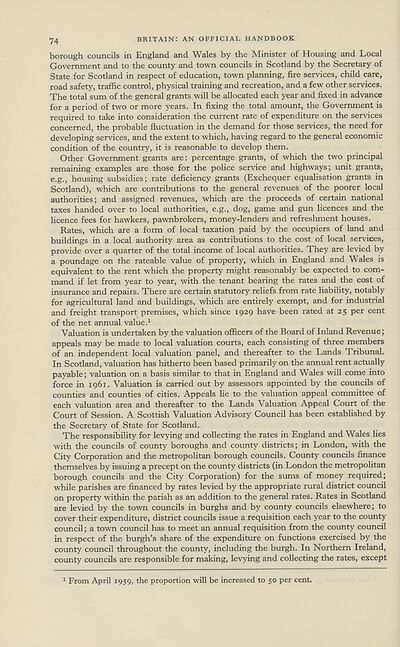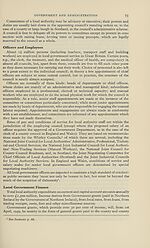Download files
Complete book:
Individual page:
Thumbnail gallery: Grid view | List view

BRITAIN: AN OFFICIAL HANDBOOK
74
borough councils in England and Wales by the Minister of Housing and Local
Government and to the county and town councils in Scotland by the Secretary of
State for Scotland in respect of education, town planning, fire services, child care,
road safety, traffic control, physical training and recreation, and a few other services.
The total sum of the general grants will be allocated each year and fixed in advance
for a period of two or more years. In fixing the total amount, the Government is
required to take into consideration the current rate of expenditure on the services
concerned, the probable fluctuation in the demand for those services, the need for
developing services, and the extent to which, having regard to the general economic
condition of the country, it is reasonable to develop them.
Other Government grants are: percentage grants, of which the two principal
remaining examples are those for the police service and highways; unit grants,
e.g., housing subsidies; rate deficiency grants (Exchequer equalisation grants in
Scotland), which are contributions to the general revenues of the poorer local
authorities; and assigned revenues, which are the proceeds of certain national
taxes handed over to local authorities, e.g., dog, game and gun licences and the
licence fees for hawkers, pawnbrokers, money-lenders and refreshment houses.
Rates, which are a form of local taxation paid by the occupiers of land and
buildings in a local authority area as contributions to the cost of local services,
provide over a quarter of the total income of local authorities. They are levied by
a poundage on the rateable value of property, which in England and Wales is
equivalent to the rent which the property might reasonably be expected to com¬
mand if let from year to year, with the tenant bearing the rates and the cost of
insurance and repairs. There are certain statutory reliefs from rate liability, notably
for agricultural land and buildings, which are entirely exempt, and for industrial
and freight transport premises, which since 1929 have been rated at 25 per cent
of the net annual value.1
Valuation is undertaken by the valuation officers of the Board of Inland Revenue;
appeals may be made to local valuation courts, each consisting of three members
of an independent local valuation panel, and thereafter to the Lands Tribunal.
In Scotland, valuation has hitherto been based primarily on the annual rent actually
payable; valuation on a basis similar to that in England and Wales will come into
force in 1961. Valuation is carried out by assessors appointed by the councils of
counties and counties of cities. Appeals lie to the valuation appeal committee of
each valuation area and thereafter to the Lands Valuation Appeal Court of the
Court of Session. A Scottish Valuation Advisory Council has been established by
the Secretary of State for Scotland.
The responsibility for levying and collecting the rates in England and Wales lies
with the councils of county boroughs and county districts; in London, with the
City Corporation and the metropolitan borough councils. County councils finance
themselves by issuing a precept on the county districts (in London the metropolitan
borough councils and the City Corporation) for the sums of money required;
while parishes are financed by rates levied by the appropriate rural district council
on property within the parish as an addition to the general rates. Rates in Scotland
are levied by the town councils in burghs and by county councils elsewhere; to
cover their expenditure, district councils issue a requisition each year to the county
council; a town council has to meet an annual requisition from the county council
in respect of the burgh’s share of the expenditure on functions exercised by the
county council throughout the county, including the burgh. In Northern Ireland,
county councils are responsible for making, levying and collecting the rates, except
1 From April 1959, the proportion will be increased to 50 per cent.
74
borough councils in England and Wales by the Minister of Housing and Local
Government and to the county and town councils in Scotland by the Secretary of
State for Scotland in respect of education, town planning, fire services, child care,
road safety, traffic control, physical training and recreation, and a few other services.
The total sum of the general grants will be allocated each year and fixed in advance
for a period of two or more years. In fixing the total amount, the Government is
required to take into consideration the current rate of expenditure on the services
concerned, the probable fluctuation in the demand for those services, the need for
developing services, and the extent to which, having regard to the general economic
condition of the country, it is reasonable to develop them.
Other Government grants are: percentage grants, of which the two principal
remaining examples are those for the police service and highways; unit grants,
e.g., housing subsidies; rate deficiency grants (Exchequer equalisation grants in
Scotland), which are contributions to the general revenues of the poorer local
authorities; and assigned revenues, which are the proceeds of certain national
taxes handed over to local authorities, e.g., dog, game and gun licences and the
licence fees for hawkers, pawnbrokers, money-lenders and refreshment houses.
Rates, which are a form of local taxation paid by the occupiers of land and
buildings in a local authority area as contributions to the cost of local services,
provide over a quarter of the total income of local authorities. They are levied by
a poundage on the rateable value of property, which in England and Wales is
equivalent to the rent which the property might reasonably be expected to com¬
mand if let from year to year, with the tenant bearing the rates and the cost of
insurance and repairs. There are certain statutory reliefs from rate liability, notably
for agricultural land and buildings, which are entirely exempt, and for industrial
and freight transport premises, which since 1929 have been rated at 25 per cent
of the net annual value.1
Valuation is undertaken by the valuation officers of the Board of Inland Revenue;
appeals may be made to local valuation courts, each consisting of three members
of an independent local valuation panel, and thereafter to the Lands Tribunal.
In Scotland, valuation has hitherto been based primarily on the annual rent actually
payable; valuation on a basis similar to that in England and Wales will come into
force in 1961. Valuation is carried out by assessors appointed by the councils of
counties and counties of cities. Appeals lie to the valuation appeal committee of
each valuation area and thereafter to the Lands Valuation Appeal Court of the
Court of Session. A Scottish Valuation Advisory Council has been established by
the Secretary of State for Scotland.
The responsibility for levying and collecting the rates in England and Wales lies
with the councils of county boroughs and county districts; in London, with the
City Corporation and the metropolitan borough councils. County councils finance
themselves by issuing a precept on the county districts (in London the metropolitan
borough councils and the City Corporation) for the sums of money required;
while parishes are financed by rates levied by the appropriate rural district council
on property within the parish as an addition to the general rates. Rates in Scotland
are levied by the town councils in burghs and by county councils elsewhere; to
cover their expenditure, district councils issue a requisition each year to the county
council; a town council has to meet an annual requisition from the county council
in respect of the burgh’s share of the expenditure on functions exercised by the
county council throughout the county, including the burgh. In Northern Ireland,
county councils are responsible for making, levying and collecting the rates, except
1 From April 1959, the proportion will be increased to 50 per cent.
Set display mode to:
![]() Universal Viewer |
Universal Viewer | ![]() Mirador |
Large image | Transcription
Mirador |
Large image | Transcription
The item on this page appears courtesy of Office for National Statistics and may be re-used under the Open Government Licence for Public Sector Information.
| Britain and UK handbooks > Britain: An official handbook > 1959 > (94) |
|---|
| Permanent URL | https://digital.nls.uk/204571785 |
|---|
| Attribution and copyright: |
|
|---|---|
| Description | 'Britain: An official handbook' was produced annually by the Central Office of Information from 1954-1998. There are 44 volumes available here to view. |
|---|---|
| Shelfmark | GII.11 |
| Description | Three titles produced by the British Government from 1954-2005 describing 'how Britain worked'. They are: 'Britain: An official handbook' (1954-1998), 'Britain: The official yearbook of the United Kingdom' (1999-2001), and 'UK: The official yearbook of the United Kingdom of Great Britain and Northern Ireland' (2002-2005). These 50 reports provide an overview of Britain's economic, social and cultural affairs, its environment, international relations, and the systems of government. They give an impartial summary of government policies and initiatives, and explain how public services are organised. |
|---|---|
| Additional NLS resources: |
|

